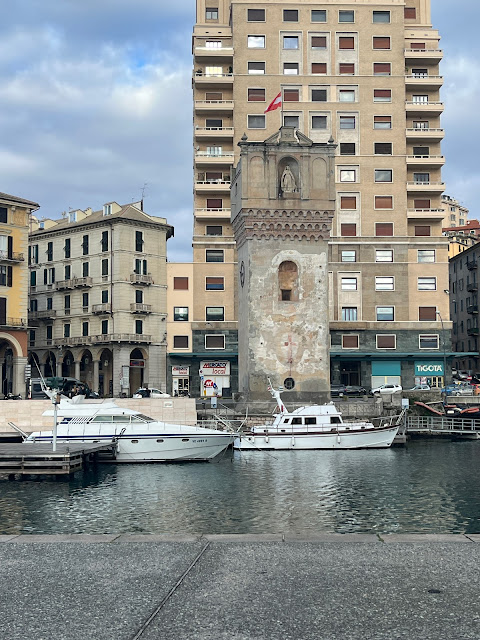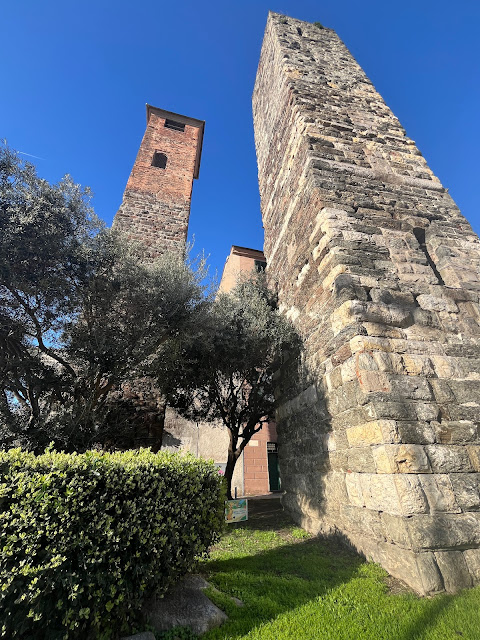Savona, Italy
Watch a video of our time in Savona here:
Savona Italy
In 2024 we went on a Mediterranean Cruise and one of our stops was Savona, Italy. I opted not to do one of the ship's shore excursions but instead to plan our day myself. It was easy-going and easy to follow. Here's what we did:
- La Torretta
- Piazza del Brandale
- Fortezza del Priamar
- Cappella Sistina
- Museo della Ceramica di Savona
- Palazzo dei Pavoni
- Palazzo delle Palle
- Piazza Mameli
- All About Apple Museum
Right next to the dock is La Torretta, or Torre Leon Palcado, a small tower that used to be part of the city walls that protected the city and dates back to at least 1392.
It was only a four minute walk from our ship to La Torretta. This medeival tower is 75 feet high. It was named after Leon Pancaldo, an explorer from Savona, who participated in the first circumnavigation of the globe led by Magellan. La Torretta is the symbol of the town of Savona.
Only a four minute walk from La Torretta is La Torre Brandale in Piazza del Brandale. It is believed that the tower was built around the 11th century, but no documents of its construction have ever been discovered. The bell in the tower is called the Campanassa and it rings every hour and half hour, as well as to announce important events in the city. Next to the Brandale tower are the Corsi and Guarnero towers, and behind the tower are ruins of other towers as well (Riario, Gambanara, and Bresciano). You can read more about the history of the Brandale tower here:
La Torre Brandale
 |
| Brandale Tower is the tallest, reaching 164 feet in height, with Corsi and Guarnero towers to the left of it in this photo. You can enter Brandale Tower on Saturdays from 9:30 a.m. to 12:30 p.m. March through November, with a guided tour. |
To go inside the Brandale Tower and see the Campanassa bell and views from the top, visit this link:
Just a five minute walk from the Brandale Tower is the Priamar Fortress, which you can see throughout Savona. It was built in the 1500's to protect Savona and also to keep the people of Savona under control. At one point the fortress was used as a prison. Giuseppe Mazzini, an Italian politician and activist, was imprisoned here during Risorgimento (the unification of Italy). Priamar Fortress could house 500 prisoners and was the country's main prison until 1903. Entrance to the fortress itself is free, although there are other tours and events that you can pay for. There is a museum on site, although it wasn't open when we visited.
 |
| The Priamar Fortress |
 |
| These ceramic balls each have names and were created by local artists |
 |
| This is the ramp up to the fortress from the street below |
 |
| view from the fortress |
Next a four minute walk will take you to Cappella Sistina, or the Sistine Chapel of Savona. There are four sites you can visit in this area, the Duomo monumental complex. It costs ten euro to see all four, which is what we chose to do. Once paying the entrance fee you can visit the Sistine Chapel on your own, but you have to be escorted by a guide for the Pope's apartment, the Cathedral, and the treasury. Our guide was a former high school pottery teacher, and obviously very passionate about the area, and particularly about the sacred sites he was explaining. He explained in great detail as he led us through the Pope's apartment and then through the treasury and Cathedral.
 |
| Inside the Sistine Chapel of Savona, which was built from 1480 to 1483 |
 |
| The ceiling of the Cappella Sistina, which was painted by Paolo Gerolamo Brusco |
 |
| This is the back of the room. The organ pipes are behind those decorative doors |
 |
| This is inside the apartment of Pope Pius VII. He was held prisoner here by Napoleon for three years. |
 |
| The bust of the pope, above a painting of Napoleon |
 |
| This is where the pope would have been seated to see visitors, although there would not have been much need for that since he was held captive and not allowed to communicate with members of his church. |
 |
| The pope's bedroom |
Napoleon wanted Pope Pius the 7th to give up his temporal power. When the pope didn't yield, Napoleon invaded the Papal States and took the temporal power of the papacy by force. The pope excommunicated him, which led to the pope's captivity in Savona. The apartment that we toured included dining quarters, a small study or office, a bedroom, a servants quarter, and a place where the pope could view what was going on down in the cathedral. He could not, however, communicate with members of his church, except through an elaborate secret network that smuggled his messages out of Savona. You can read more about Pope Pius VII's captivity here:
.JPG) |
| The Cathedral of our Lady of the Assumption in Savona was built in the 16th century. Some of St. Valentine's remains are on display here during the week before Valentine's Day. |
.JPG)
.JPG) |
| some of the art in the Treasury Museum |
Only one minute away from the Savona Cathedral is the Ceramics Museum, which has an entrance fee of five euro. On display is ceramic art from Renaissance time through the 20th century. There are four floors, with almost 1,000 pieces of art.
.JPG) |
| The Ceramics Museum is inside Palazzo del Monte di Pietà, only steps away from Savona Cathedral |
Information about the Ceramics Museum can be found here:
Ceramics Museum of Savona
Two palazzos that I had heard about were next on my itinerary - Palazzo dei Pavoni, or Palace of the Peacocks, and Palazzo delle Palle, or Palace of the Balls. Both were designed by Alessandro Martinengo, who took his inspiration from Gaudi & his famous Barcelona architecture, and were built around 1910. They are both an example of Art Nouveau.
.JPG) |
| Palace of the Peacocks - Palazzo dei Pavoni, built in 1910 |
.JPG) |
| Palace of the Balls -- Palazzo delle Palle, built between 1910 and 1911 |
.JPG) |
| This photograph of Palazzo delle Palle is on display in Zelo Gelataria, which is on the ground level of Palazzo delle Palle and has delicious gelato! |
.JPG) |
| Zelo Gelataria |
One of the most unique things about Savona is the ringing of the bell in Piazza Mameli at 6 p.m. I was sad that we didn't get to witness this nightly event, because our cruise ship left the dock at 6 p.m. Every night since September 18, 1927, traffic and pedestrians come to a halt around Piazza Mameli as the Bell of the Memorial rings 21 times. This is to commemorate the bravery of fallen soldiers in all wars. I saw a video of this occurrence here:
I would have loved to see the ringing of the bell in action!
We ate lunch at a Kebab Pizzeria, but there were countless places to eat in Savona!
While walking back towards the dock, we discovered that the swing span bridge was open. A sailboat was making its way from the harbor into the marina, so the bridge had to be opened to let it pass by. Lots of people watched as the boat sailed through, and then we waited for the bridge to rotate back into place. As it rotated, a recording repeated in Italian and English, "the bridge is rotating, stay away from the forbidden area." As soon as it locked in place, the gates opened on either side and pedestrians made their way across.
.JPG) |
| rotating bridge moving back into place |
Our last stop of the day was the All About Apple Museum, which is right next to the cruise ship dock. The entrance fee is 7 euro. On display are apple computers and game consoles dating back to 1976 until present day. The computers are powered up and ready to be played with. Old iphones, ipads, ipods, atari, etc. are housed in this museum.
You can read more about the All About Apple museum here:
We did a little bit of shopping before returning to the ship. If we'd had more time we could have visited one of the former homes of Christopher Columbus, one of the most famous former residents of Savona. One of his homes is a cottage situated in the Savona Hills. That will have to wait for next time!
.JPG) |
| One last look at La Torretta from our ship balcony, as our ship was departing the dock. |










.JPG)
.JPG)
.JPG)
.JPG)
.JPG)
.JPG)
.JPG)
.JPG)
.JPG)
.JPG)










.JPG)
.JPG)
.JPG)
.JPG)
.JPG)
.JPG)
.JPG)
.JPG)
.JPG)
.JPG)
.JPG)
.JPG)
.JPG)
.JPG)
.JPG)
.JPG)
.JPG)
.JPG)
%20(1).JPG)
.JPG)
.JPG)

No comments:
Post a Comment